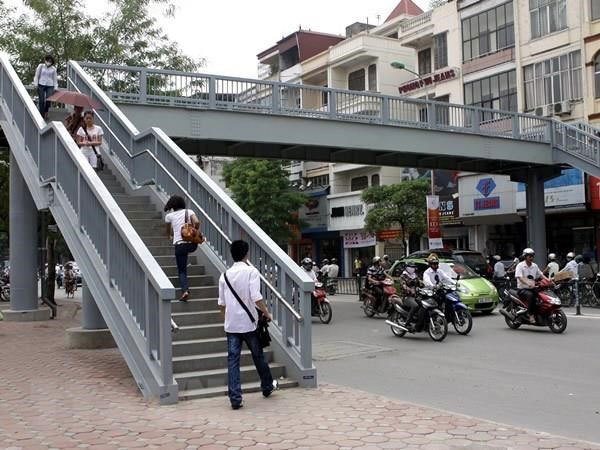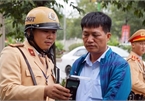 |
|
Footbridge in Chua Boc Street.
|
Despite large investment in the constructions considered part of a modern transport system, many bridges and tunnels have been neglected for years.
According to experts, pedestrians will use bridges and tunnels instead of jaywalking if they are in convenient locations, safe and clean.
Among the city's tunnels and bridges, only those in Thanh Xuan District’s Nga Tu So Intersection and Nam Tu Liem District’s Cau Dien, which are densely populated with a high density of vehicles, have a large number of pedestrians using them.
These tunnels give people a sense of security with fully equipped ventilation and lighting, signposts and security and cleaning staff.
In the tunnel in the Nga Tu So Intersection, there is a bicycle path. The tunnel is cleaned daily so people in the neighbourhood also often come down for exercise.
Nguyen Thi Dung, a security worker in Cau Dien tunnel, said that “the tunnel was often crowded. It is very safe in here.”
“There are no beggars or drug addicts in the tunnel,” she said.
Security and location a concern
But not all tunnels in the city are used by pedestrians.
Pham Hung Street is a high-density traffic route so the number of pedestrians crossing is huge but the underground tunnel in front of My Dinh bus station is almost deserted.
Garbage is scattered in front of the tunnel and tea shops are located close to the tunnel gate.
“I do not like to go through the tunnel because it is quite deserted,” said Nguyen Tra My.
“The tunnel is not clean enough and sometimes, there are drug addicts inside the tunnel,” My said.
“Moreover, there are many young men gathered in the tea shops at the entrance of the tunnel so I feel uncomfortable passing by these people,” she said.
“I prefer to cross the street rather than go through the tunnel. And I have lived in Hanoi for a long time, jaywalking is normal for me,” she said.
Thieu Dinh Dan, from Thanh Hoa Province, who runs a tea shop in front of the tunnel, said: “Old people and children are afraid of passing through the tunnel because there were drug addicts and wanderers who ask them for money.”
“The tunnel is long and dark. It floods under heavy rain,” Dan said.
With jaywalking common, it seems citizens are more afraid of miscreants in the tunnels than crossing busy streets.
The tunnel in Pham Dong Street also has few people using although it is equipped with a lighting system and is clean.
“People preferred jaywalking. It's faster than going down to the tunnel,” said Vu Thi Thuy, a resident in the area.
Crossing over the crowded street caused many tragic accidents.
“A month ago, I saw a young person have an accident when crossing the road in rush hour,” Thuy said.
Many tunnels have become degraded because there are no users and cleaning and maintenance is rarely carried out.
Though they don't have the same security issues as underground passes, many footbridges in Hanoi are also unused due to being in inconvenient positions.
Some are in good locations but have poor designs with steep and slippery stairs which are inconvenient for the elderly and disabled.
For example, the bridge between Giang Vo and Ngoc Khanh streets is modern but lacks synchronisation with surrounding infrastructure so few people use it.
The bridge is now degraded and rusty.
The bridge near the University of Social Sciences and Humanities on Nguyen Trai Street of Thanh Xuan District is in the same situation.
Every day, hundreds of students cross the busy street because the bridge is far from the bus stops and the university’s gate.
Lack of awareness
Lack of awareness of the Law on Road Traffic also leads to pedestrian tunnels and bridges being unused.
In rush hour, few people using bridges in busy streets such as Nguyen Chi Thanh, Hoang Quoc Viet and many pedestrians risk their lives by crossing busy streets.
“It is a bit dangerous but walking through the road is faster and more convenient,” said Nguyen Trung Hieu, a student in Nguyen Chi Thanh Street.
“Walking on the bridge takes time,” he said.
According to Hanoi Transport Department, the city has 46 footbridges and 31 tunnels for pedestrians.
The municipal People’s Council recently approved projects of building six footbridges with total capital of VND34.6 billion (US$1.5 million).
To get more people using the transport infrastructure works, the department has used several measures including information dissemination about road traffic laws, especially primary and secondary students via curriculum in schools.
The department has enhanced technical measures to force pedestrians to use underground passes and footbridges such as fencing and planting trees in median strips to prevent people crossing the roads.
Tougher fines for pedestrians who violate the Law on Road Traffic have also been mooted. VNS

Nearly 101,470 traffic violation cases handled in one week of stricter inspections
Up to 101,469 cases of violation were handled in the first seven days of the tightened road inspections from May 15 to 22, with fines totaling 75.7 billion VND (3.25 million USD).

Using mobile phone when driving may be strictly banned
It may be illegal to use mobile phone when driving or riding a vehicle, according to the Law on Road Traffic Order and Safety being drafted by the Ministry of Public Security.
 Many pedestrian bridges and underground passages in Hanoi are largely unused due to their inconvenience and safety concerns, according to baotintuc.vn.
Many pedestrian bridges and underground passages in Hanoi are largely unused due to their inconvenience and safety concerns, according to baotintuc.vn.